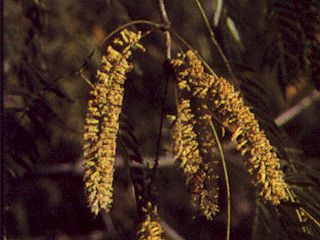HONEY MESQUITE
Prosopis glandulosa - Mimosaceae, Mimosa Family
DESCRIPTION:
-
Medium to small tree with rounded
crown and crooked, drooping branches; feathery foliage; straight paired spines
on twigs.
-
Height. 20-30 feet, up to 50 feet.
-
Flowers: Pale yellow elongated
spikes; March to November.
-
Fruit. 4 to 9-inch-long, narrow and
-
straight, yellowish pods.
-
Foliage. Deciduous, delicate, airy
foliage.
-
Bark: Grayish with deep furrows and
thick ridges, varying considerably
with age. Growth rate Medium.
REQUIREMENTS:
-
Sun: Full sun.
-
Soil.- Any.
-
Drainage: Well-drained.
-
Water. Low; drought tolerant.
-
Maintenance. Little; pods and
leaflets createground litter.
-
Propagation: Seed, root cutting.
NATIVE HABITAT:
Brush-grasslands.
WILDLIFE USE:
Pods consumed (seeds pass through
undigested), by coyotes, skunks, wood rats, ground squirrels, jackrabbits,
cottontails, javalina, white-tailed deer, live-stock, humans; birds (quafl and
doves) use seeds; shelter, cover, and shade; nest sites; bees collect nectar for
honey.
COMMENTS: Used as fence posts, furniture, building beams, fuel, charcoal. Good
ornamental tree in the landscaped lawn because of the interesting asymmetrical
spreading form; the elegant individualized free-form shape is best utilized in
large open areas.
|

